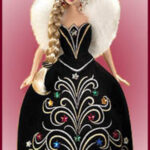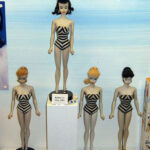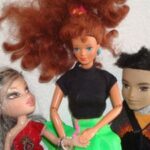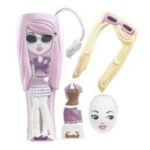It seems as if every time anyone writes or talks about the issue of young women’s unhealthy preoccupation with trying to achieve the perfect body it doesn’t take long before one name inevitably gets mentioned – Barbie. The Barbie doll, which was introduced when I was a child, is blamed for all those little girls who grew up wanting to have the small hips, flat tummy, and generally perfect-for-clothes build of Barbie. More significantly, Barbie is often blamed for the unhealthy practices many girls and women adopt in order to try to achieve a physique as attractive as the fashion doll’s.
Barbie is also frequently blamed for “sexualizing play” for little girls. After all, the doll that was designed to look nice in clothes was designed with a build aimed at just that. It just so happens that a fashion doll with grown-up clothes looks best with the body parts of a woman, which apparently equals sexualizing to anyone who believes little girls should not be exposed to the
grown-up build of Barbie.
Last week ABC’s 20/20, which was addressing the issue of vanity and plastic surgery, included the remarks of playwright, Eve Ensler, who was yet one more voice to disparage Barbie and the impact she may potentially have on little girls’ self-image. After seeing Barbie blamed yet one more time I decided to do some research and write an article about Barbie and why people shouldn’t blame “her” for the self-image problems of girls and women. My theory is that heterosexual girls and women are not going to find what they see in the mirror attractive because they find the male physique attractive, and that their quest to make themselves more attractive may include a combination of following fashion and beauty trends (today the big thing – pardon the pun – is breasts and cleavage) and aiming for physical attributes associated more often with both men and good health/ fitness (more defined muscles and slim hips, for example). My personal experience with Barbie, and the experience of those girls and women with whom I’ve discussed this subject, has primarily been one of enjoying the miniature clothing and accessories that have always been available for the doll – the way any collector of any type of miniatures appreciates his or her collection. Of course, most of the women I know have said they enjoyed the fantasy play involved with Barbie. They pretended the doll went to proms, to the beach, to work, or shopping. Admittedly, many of the women my age remember the television commercial for Barbie and the song that said, “…you make me feel my Barbie doll is real.” Even with that, though, women I know have said that while they may have imagined the tiny fashion doll as real they never particularly imagined her as anything more than a doll surrounded by fantasy. In other words, I don’t know any girl or woman who has confused her own identity with that of Barbie.
Upon researching Barbie I found, somewhat to my surprise, that the doll has also been blamed for promoting materialism in girls. Barbie has also been criticized for not always being seen as intelligent. While these criticisms may or may not be well founded, a more disturbing fact about Barbie – the doll who has come to represent all the things associated with being a young woman (looking pretty, liking clothes, living a busy life, travel, work, dreams, dates, best friends and little sisters) – is that studies have revealed a high rate of “torture play” and “anger play” is associated with the Barbie doll (“Early adolescents’ experiences with, and views of, Barbie”, Adolescence, Spring, 2004 by Tara L. Kuther, Erin McDonald).
One study showed that girls have admitted to things such as having a bad day at school and coming home and taking it out on Barbie. A high rate of “torture play”, including things such as “killing” the doll, pulling the head off, cutting it, burning it, and doing other things to destroy the doll as been associated with Barbie and children of both genders. One girl buried naked Barbie dolls in the snow and left them there until the thaw. She then brought the dolls in and used scissors for chicken bones to cut the dolls in half. Disfiguring and damaging the dolls is also something in which boys engage (with other boys or sisters). Burning the dolls at the stake is one activity reported by boys. Trying to think of ways to”hurt” the doll is another. Based on the article by Kuther and McDonald, it appears that torture play is often engaged in by more than one child at a time.
Girls reported hating Barbie because she’s perfect even though the same girls or other girls may have also liked the doll. Barbie has also not been liked because she’s associated with the color, pink. Apparently, there are girls who hate pink.
According to Kuther and McDonald, “There is a paucity of empirical research examining the impact of Barbie dolls on the lives of girls.” While there may not be much in terms of empirical research related to the impact Barbie dolls have on the lives of girls, there is plenty of evidence to show that this icon of femininity may be far more a victim than a villain. According to Abigail Natenshon, MA LCSW and Author of “When Your Child Has An Eating Disorder, while Barbie and the media “undoubtedly” influence the way young people think about themselves, her article, “Parental Influence Takes Precedence Over Barbie and The Media (www.empoweredparents.com) parents do make a difference.
So, as the question of Barbie’s negative impact on girls continues to be debated among people who believe that Barbie’s perfection is too unrealistic to be healthy and those people who absolutely loved Barbie dolls, without ever imagining that they may be expected to look like them, I’d like to raise what may be an even more sobering question: Barbie represents the perfect young woman with a pretty face (of any color these days), beautiful hair, a very feminine and perfect figure, achievement, friends, and any number of other things associated with the dreams of young women. Isn’t it a sign of some sort of collective misogyny and/or abusive thinking that Barbie is blamed for so many ills, accused of so many destructive things, resented and/or hated for her perfection, and even brutalized and disfigured? Think about it. Here is Barbie, this fictitious character, who was created in one form of perfection or another through no fault of her own. Today’s Barbie is strong, intelligent, adventurous, accomplished, and – yes – someone who still likes pink. She represents young women of all colors and nationalities as well. She also – in her own way – represents little girls.
Barbie is not an action hero who beats up or shoots up anyone who opposes her. She’s still got wholesomeness when dolls like Bratz don’t. She’s apparently a hard worker and seems to be liked by all those friends of hers. She hurts nobody, and yet she is like so many women who live in abusive environments where they are blamed for things that aren’t their fault, treated with suspicion, resented, used as punching bags when someone has had a bad day, and brutalized. This pretty little doll, with her miniature accessories and the ability to capture the imaginations of little girls (and not so little girls) everywhere isn’t really guilty of anything other than being perfect and perfectly feminine.
Barbie may actually represent femininity more than people realize. Whether it is time to stop asking what’s wrong with Barbie and start asking what’s wrong with the young people who resent her, see her as their role model, or brutalize her may be the real question.








